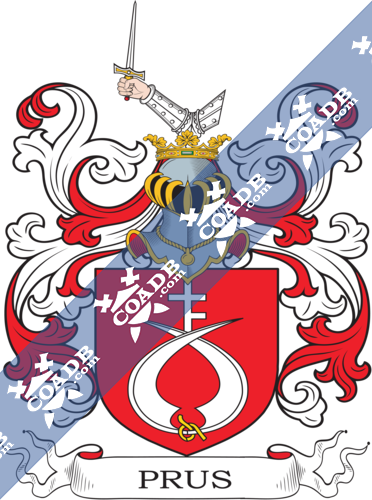Prus Family Crest, Coat of Arms and Name History

Prus Coat of Arms Gallery
Don’t know which Coat of Arms is yours?
We can do a genealogical research. Find out the exact history of your family!
Learn MorePrus is an old Polish demonym used while referring to a person hailing from old Prussia (before the Teutonic conquest). According to a legend, the arms “Prus” was granted by king Bolesław II the Generous to three Prussian princes, who settled in Poland after the martyrdom of St. Adalbert of Prague in 997. The cross was an obvious charge, because the princes were converted pagans. The legend is at least partially true, because Polish genealogists agree on a fact that early members of the Prus clan arrived sometime in XIII century from old Prussia to Mazovia, where they intermarried with local minor nobility and perhaps even adopted and modified its arms. Coat of arms “Prus” is among the oldest Polish coats of arms. The oldest known mention of “Prus” arms is from 1389, and its oldest depiction is on seal from 1456. Coat of arms “Prus” was known under alternative names Półtora Krzyża (One-and-a-half cross), Słubica, Turzyna, Wagi, Wiskałła, Wiskawa, Wiszczała.
Typically for Polish heraldry, in the course of ages the “Prus” clan expanded to include many noble families, of which some were probably even unrelated. This happened because in XV-XVI century, descendants of the Prus clan used to adopt new surnames alluding to names of their home villages and also adopted other, unrelated and possibly poorer families, who during the war time fought under the “Prus” banner. Currently, the heraldic researches associate these arms with a total number of 391 surnames, with the surname Prus and its variants (Prusewicz, Prusiecki, Pruski, Pruss, Pruś, Pruszanowski, Pruszewski) being just a few out of many. According to Polish heraldist from XVIII century, Kasper Niesiecki, the most prominent families entitled to use the “Prus” coat of arms were: Andrzejewski, Biestrzykowski, Bogusławski, Borowski, Bystram, Chomętowski, Chwałkowski, Cygański, Długojewski, Dobrodziejski, Drozdowski, Druszkowski, Dymitrowski, Frycowski, Garlicki, Gawłowicki, Głowacki, Gniewiewski, Goworowski, Grzymisławski, Isaykowski, Jeżowski, Juchnowski, Julewski, Jurecki, Kaczkowski, Klicki, Kliczkowski, Korycki, Krzywokulski, Krzyżakowski, Łącki, Łątkiewicz, Łososiński, Michalczewski, Mroczek, Nielepiec, Niemczykowski, Niewiadomski, Obrzycki, Ormieński, Orzeł, Ossowski, Otocki, Petryczyn, Piszczański, Płoński, Podleski, Polikowski, Przechowski, Przezdziecki, Raczkowski, Rokotowski, Rożanka, Rudowski, Ruwski, Rywocki, Ślepczyc, Słubicki, Spinek, Stradomski, Studzieński, Szamowski, Szczepanowski, Swarocki, Tobaszowski, Trembecki, Więckowski, Wiśniewski, Woliński, Wolski, Zajączkowski, Załęski. Full list of surnames can be viewed here.
Probably the most widely known member of Prus clan was Bolesław Prus, real name Aleksander Głowacki (1847-1912), Polish novelist, journalist, short-story writer. Prus arms is also associated with bishop Stanislaus of Szczepanów (1030-1079), martyr and one of the saint patrons of Poland and Kraków city, although he lived long before Prus coat of arms was even mentioned. Polish modernist painter and art critic Eligiusz Niewiadomski (1869-1922) was also a member of Prus clan. Wacław Szybalski (born 1921 in Lwów), currently a professor of oncology at the McArdle Laboratory for Cancer Research, University of Wisconsin–Madison Medical School, comes from Prus clan. Certain sources associate with Prus clan a Republican member of the US House of Representatives from New York, Polish-American Joseph Mruk (1903-1995).
It is possible, that two other Polish arms and clans were spawned from Prus, by addition of new elements to the old Prus arms. They are also called Prus: Prus II (Prus secondo) which spawned further modification called Prus III (Prus tertio).
Coat of arms Prus II according to a legend was granted around 1047 to a knight coming from Prus clan. The knight fought for Polish prince Casimir I the Restorer as a commander-in-chief against the rebellious Miecław, a self-proclaimed prince of Mazovia. For his bravery and sacrifice (he was twice wounded) he received and addition to old arms in form of two wolf-hooks – taken from coat of arms of the knight’s opponent. The oldest mention of “Prus II” arms is from 1401, while its oldest depiction is on seal from 1402. Its alternative names are Wilczekosy, Wilcze Kosy, Falcastrum Lupinum (Wolf hooks), Słubica.
Currently, the heraldic researches associate “Prus II” arms with a total number of 105 surnames. It is worth noting that the surname Prus is not on this list, only its one variant, Pruski. According to Polish heraldist from XVIII century, Kasper Niesiecki, the most prominent families entitled to use the “Prus II” coat of arms were: Baworowski, Dębowski, Głuchowski, Daniecki, Faszczewski, Grzybowski, Jezierski, Kobyliński, Łaźniewski, Małachowski, Misiewski, Mitnarowski, Myślecki, Nakwaski, Niewierski, Nowomiejski, Olszewski, Preczkowski, Pruski, Radomiński, Wołowski, Zaborowski, Zglinicki. Full list of surnames can be viewed here.
Coat of arms Prus III according to a legend was adopted by a descendant of the knight who received Prus II coat of arms. He married a very wealthy girl from Pobóg clan, who bore in her arms a horseshoe with a cross on an azure field. The knight decided to create a whole new coat of arms by mixing his and his wife’s arms. The descendant of this knight, who lost his leg during a battle for king Bolesław, received golden armed leg in crest from grateful king. The oldest mention of Prus III is from 1415, while its oldest depiction is on a seal from 1461. Alternative name of Prus III is Nagody, which means To the wedding and alludes to its legendary beginning.
Currently, the heraldic researches associate “Prus III” arms with a total number of 125 surnames. It is worth noting that the surname Prus is not on this list, only its variants: Prossewski, Proszewski, Prószewski, Prusiecki, Pruski, Prusakowski, Pruszkowski. According to Polish heraldist from XVIII century, Kasper Niesiecki, the most prominent families entitled to use the “Prus III” coat of arms were: Bełdycki, Bogdański, Byszyński, Czarnecki, Dawidowski, Dłużniewski, Dobrzyniecki, Glaznocki, Jabłonowski, Jaruntowski, Karniski, Korewicki, Kowalewski, Łosowski, Miński, Mlącki, Młocki, Mroczkowski, Mrozowicki, Napiorkowski, Nogalski, Opacki, Osowiński, Pisanka, Pruszkowski, Radomski, Rosochacki, Rudziński, Rzeczkowski, Skowroński, Słucki, Wichulski, Wietwiński, Zieleński, Zuchorski, Żukowski. Full list of surnames can be viewed here.
Probably the best known Polish figure from Prus III clan was Stanisław Jabłonowski (1634-1702), Polish military commander under king Jan III Sobieski. His descendants acquired titles of counts and dukes, and his grandson Stanisław Leszczyński was king of Poland in 1704-1709 and 1733-1736.
Blazons & Genealogy Notes
1) “War cry (zawołanie): Turzyna! Wiskała! First notation: 1389 W polu czerwonym półtorakrzyża srebrnego. W klejnocie ramię zbrojne z mieczem, srebrne.”
2) “War cry (zawołanie): Na Gody! Na pole! First notation: 1401 W polu czerwonym dwie wilczekosy srebrne złączone w dole i związką złotą powiązane, tak, że koniec jej wisi, zachodzące ostrzami na siebie z zaćwieczonym tamże półtorakrzyżem srebrnym, którego dolne ramię w lewo, w klejnocie ramię zbrojne w łokciu zgięte z mieczem w lewo zaniesione.”
“War cry (zawołanie): Na Gody! Na pole!
3) First notation: 1415 Tarcza w słup dzielona, w polu prawym czerwonym – wilczakosa srebrna ostrzem w dół ku środkowi obrócona, w polu lewym błękitnym – pół podkowy srebrnej z zaćwieczonym na nich półtorakrzyżem złotym, którego ramię dolne w prawo, w klejnocie noga zbrojna z ostrogą, w kolanie zgięta, stopą w lewo.”









